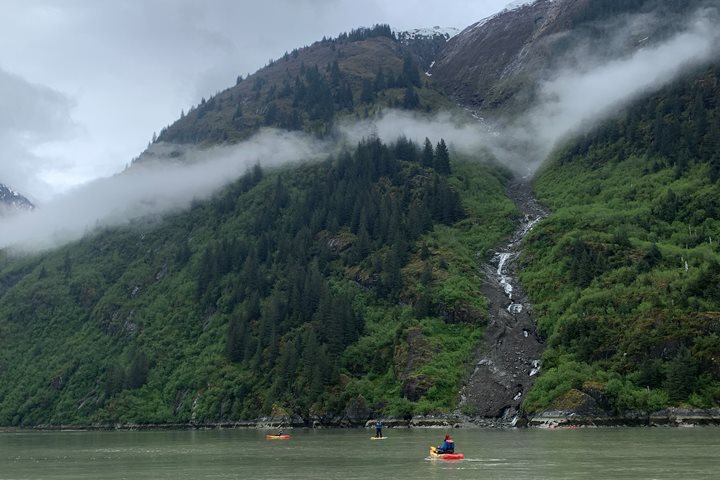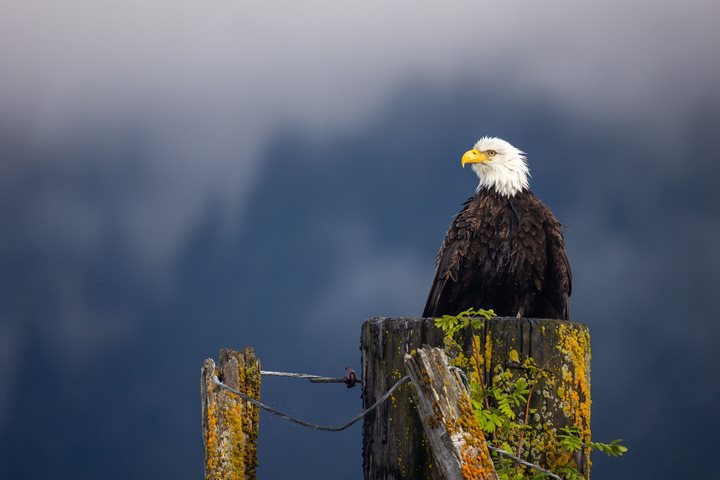As the sun rose, National Geographic Sea Lion made her way through Peril Strait. Guests on the bow were greeted with a glorious parade of layer upon layer of gold, grey, black, yellow, and hints of blue as the sun reached through the clouds and opened up onto Peril Strait. This stretch of water separates Baranof Island and Chichagof Island. On the eastern end of Peril Strait, the entrance to Chatham Strait begins. As recently as 15,000 years ago, the ice was more than a mile thick over this strait. The moving, flowing ice exploited natural faults and lines of weakness in the bedrock of the region, gouging out valleys that were flooded by the sea when the ice finally retreated. It was this glacial ice that carved Chatham Strait and many of the smaller fjords that make up much of Southeast Alaska, often called the Land of 1,000 Islands.
Traveling through these protected waters with mountains on many sides, we were searching for marine mammals. It is rumored that we were in a particular territory where humpback whales find their summer feed. It was the humpbacks’ style of feeding that we were searching for. Could we…would we…find bubble-net feeders? That was the question of the day! Just after breakfast and morning briefings, the bridge radioed our expedition leader. Bubble-netters had been spotted! The bridge crew made their way towards a large group of humpback whales. It was estimated that fifteen animals were in the group. We could see the blows and the flukes as the animals came up for deep breaths and then dove…up and down, up and down. Then the group dove together, and we waited…and waited. As birds circled overhead, we waited for them to give us the signal by diving deeply for the water. Exploding to the surface, the entire group of humpback whales rose, mouths agape as they took in massive amounts of water and small schooling fish! Wow! This group of whales continued their feeding behavior over and over. We observed the whales’ blows and dives near National Geographic Sea Lion as we watched this group of bubble-net feeders continue their morning feeding.
Time flew by. All too soon, it was time for lunch. Returning downstairs for another great meal, we refueled for an afternoon hike on Chichagof Island. Once ashore by Zodiac, we separated into several groups and began exploring the coastal temperate rainforest of Southeast Alaska. These rainforests exist all along the Northwest Coast of North America, from Southeast Alaska to California. It is late summer / early fall, and many mushrooms are beginning to show themselves. They grow from the deep mycelium that covers the forest floors of the world. Just under a thin layer of soil, the threads of many species of mycelium are the true carpets of our planet’s forest floor. The fruiting bodies of these mycelium species, which are the mushrooms we recognize each fall, arise when weather conditions are right: cooler temperatures, some rain, and shorter days!
Walking along a well-established brown bear trail, we made our way towards a small river where humpy or pink salmon were returning to spawn. Bear footprints were all around. Birds were waiting for a chance to feed as the cycle of the salmon’s life came to an end. Pink salmon return every two years to spawn, and our hikes took place at the perfect time to observe another cycle of nature. When the salmon return to the rivers of Southeast Alaska, they nourish the forests, brown bears, bald eagles, various scavengers, smaller birds and animals, and also the many fishermen who ply the saltwater at the entrances to the salmon rivers.
Once again, it was time for us to return to our beach and our waiting Zodiacs for a second round of activities…more hiking? Or a Zodiac cruise to search for our morning humpbacks and view bubble-net feeders from the water? Hikers departed as Zodiacs pulled away, following the blows in the distance. After a long, bumpy ride, we were, once again, in the presence of a good-sized group of large animals, observing from what felt like very small vessels! We were closer to the sounds, closer to the wind, and closer to the blows of the animals and the birds circling overhead. We “whale waited.” We were patient. Soon we observed a massive surge of humpback whales as they rose to the surface. Water spilled from their huge mouths as they filtered out seawater, trapping the small schooling fish in their baleen. As the light began to change, we returned to National Geographic Sea Lion along with the hikers. To say it was an amazing first day is hardly enough. We all had a chance to be present in a place full of beauty. May this place remain as it is for many more visitors to enjoy in the years to come.







